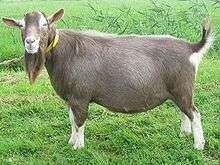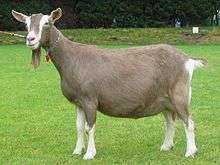Toggenburg goat
The Toggenburg or Toggenburger is a Swiss breed of dairy goat. Its name derives from that of the Toggenburg region of the Canton of St. Gallen, where it is thought to have originated. It is among the most productive breeds of dairy goat and is distributed world-wide, in at least fifty countries in all continents.[3]
 | |
| Conservation status | FAO (2007): not at risk[1]:146 |
|---|---|
| Other names |
|
| Country of origin | Switzerland |
| Distribution | worldwide |
| Standard | Schweizerischer Ziegenzuchtverband |
| Use | milk |
| Traits | |
| Weight | |
| Height | |
| Horn status | horned or hornless |
| Tassels | with or without tassels |
| |

History
The Toggenburg is the traditional goat breed of the Toggenburg and Werdenberg regions of the Canton of St. Gallen in eastern Switzerland.[4] The herd-book was started in 1890.[5]:414 At first, the goats were often dark-coated, sometimes with white markings; there may have been some cross-breeding with Appenzell and Chamois-coloured stock in neighbouring areas. The typical mouse-grey colour with white facial markings was fixed by selective breeding in the twentieth century.[5]:414
There were 850 goats in the Toggenburg and the Werdenberg region of 3000 in Switzerland, which is down from 20,000 in the 1950s. The club St. Gallen Goat Breeders Association, that was founded in 1901, registers the breed. The Verein Ziegenfreunde was formed to protect the breed and unite breed owners.[4]
British Toggenburgs are heavier and have improved milk quality. By the middle of 2002, 4146 Toggenburgs had been registered with the New Zealand Dairy Goat Breeders Association.[6]
Characteristics
The Toggenburg is of medium size. Coat colour ranges from light brown to mouse grey, with white Swiss markings to the face, lower legs and tail area.[2] Tassels may be present; billies and nannies may be naturally horned or polled (hornless).[2]
Use
The Toggenburg is a highly productive dairy breed. The breed standard calls for minimum milk yield of 740 kg per lactation, with a minimum fat content of 3.56% and minimum protein content of 2.90%.[2]
References
- Barbara Rischkowsky, D. Pilling (eds.) (2007). List of breeds documented in the Global Databank for Animal Genetic Resources, annex to The State of the World's Animal Genetic Resources for Food and Agriculture. Rome: Food and Agriculture Organization of the United Nations. ISBN 9789251057629. Accessed May 2014.
- Toggenburger Ziege (in German). Schweizerischer Ziegenzuchtverband. Archived 2 October 2016.
- Bhotia Pony/India. Domestic Animal Diversity Information System of the Food and Agriculture Organization of the United Nations. Accessed June 2015.
- "Slow Food Presidia". Retrieved December 14, 2014.
- Valerie Porter, Lawrence Alderson, Stephen J.G. Hall, D. Phillip Sponenberg (2016). Mason's World Encyclopedia of Livestock Breeds and Breeding (sixth edition). Wallingford: CABI. ISBN 9781780647944.
- "New Zealand Dairy Goat Breeders Association". Retrieved December 14, 2014.